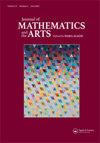数学与艺术相结合的两种互补方式
IF 0.2
Q4 MATHEMATICS, INTERDISCIPLINARY APPLICATIONS
引用次数: 0
摘要
我是一个非常注重视觉的人。高中时,我得到一本赫尔曼·魏尔(Hermann Weyl)的书《对称》(Symmetry)[12],从那时起,我就对几何产生了兴趣。正式的数学证明对我没有吸引力,除非我能得到一些直观的模型来支持这些证明。这就是为什么我对规则地图、图形嵌入和数学结等主题着迷的原因。相应的可视化模型产生了几何雕塑,即使对不了解底层数学的人也能传达美学信息。相反,布伦特·柯林斯(Brent Collins)和查尔斯·o·佩里(Charles O. Perry)等艺术家的抽象几何艺术作品促使我发现了其中潜在的数学原理,并将它们捕捉到电脑程序中,然后再用电脑程序制作出更多同类的雕塑。本文章由计算机程序翻译,如有差异,请以英文原文为准。
Two complementary ways of linking math and art
I am a very visually oriented person. Geometry has been in my blood since high-school, when I was given a copy of Hermann Weyl’s book “Symmetry” [12]. Formal mathematical proofs do not appeal to me until I can get some visualization model that supports that proof on an intuitive level. This is why I have been captivated by topics such as regular maps, graph embeddings, and mathematical knots. Corresponding visualization models have led to geometrical sculptures that convey an aesthetic message even to people who do not know the underlying mathematics. Conversely, abstract geometrical artwork by artists such as Brent Collins and Charles O. Perry have prompted me to discover the underlying mathematical principles and capture them in computer programs, which then produce more sculptures of the same kind.
求助全文
通过发布文献求助,成功后即可免费获取论文全文。
去求助
来源期刊

Journal of Mathematics and the Arts
MATHEMATICS, INTERDISCIPLINARY APPLICATIONS-
CiteScore
0.50
自引率
0.00%
发文量
19
 求助内容:
求助内容: 应助结果提醒方式:
应助结果提醒方式:


